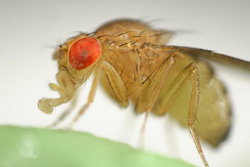The Fabric for Weaving Memory

Drosophila melanogaster<br>IMP/Solvin Zankl<br>
The details of memory formation are still largely unknown. It has, however, been established that the two kinds of memory – long term and short term – use different mechanisms. When short-term memory is formed, certain proteins in the nerve cells (neurons) of the brain are transiently modified.
To establish long-term memory, the cells have to synthesize new protein molecules. This has been shown in experiments with animals. When drugs were used to block protein synthesis, the treated animals were not able to form long-term memory.
The precise mechanism by which the newly synthesized proteins regulate memory formation is still poorly understood. They are thought to strengthen existing connections between neurons, as well as establish new connections. Both processes are required for long-term memory formation.
A nerve cell in the brain makes connections with tens of thousands of other nerve cells through so-called synapses. When memory is formed, only specific synapses, which are activated by a specific experience are modified. The mechanism of how the synthesis of new proteins can be restricted to these activated synapses has been unclear. Neurobiologists have postulated the existence of “synaptic tags”. One of the candidates is a family of proteins known to regulate local protein synthesis, the CPEB family of proteins. These proteins have been known for some time to perform important tasks during embryonic development, and recently have been identified in neuronal synapses.
In 2007, Krystyna Keleman, a neuroscientist at the Research Institute of Molecular Pathology (IMP) in Vienna, was able to show that fruit flies require CPEB proteins for long-term memory formation.
To study memory formation, the researchers at the IMP looked at the sexual behavior of flies. After copulation, female flies loose interest in the courtship advances of males. Male flies must learn – by trial and error – that only virgin females are receptive. The key to telling them apart is their smell.
Researchers at the IMP have built tiny “trainig camps” to test the memory of fruit flies. In these devices, male flies are exposed to mated females for a defined period of time. Depending on the length of the training session, the resulting memory lasts for several hours to several days.
To find out how these molecules might function in long-term memory, Sebastian Krüttner, a doctoral student with Krystyna Keleman at the IMP, devoted the past five years to this question. He identified two very similar CPEB proteins in flies, Orb2A and Orb2B, as the key molecules. While both isoforms are required for the formation of long-term memory, they function by distinct mechanisms in this process.
After conducting a large number of genetic, biochemical and behavioral experiments, the IMP scientists now propose the following model for long-term memory formation: a learning experience – as in the courtship conditioning procedure – leads to the activation of Orb2A in certain synapses only. In these synapses, Orb2A recruits Orb2B into complexes, which in turn alter protein synthesis locally only in these activated synapses, thereby forming stable memories.
This model, which is described in the current issue of the journal Neuron, is somewhat unconventional. The fact that two very similar molecules have such different functions was unexpected. Even more surprising is the role of Orb2A, which does not require its protein binding domain – a region previously thought to be essential for CPEB proteins.
The mechanism by which the two proteins interact in the formation of memory might turn out to be a basic principle for members of the CPEB family. Since these proteins are highly conserved among animals including humans, the implications could be far reaching.
The paper „Drosophila CPEB Orb2A mediates memory independent of ist RNA-binding domain“ by Sebastian Krüttner et al. was published in the journal Neuron on October 18, 2012.
About Krystyna Keleman
Krystyna Keleman was born in Warsaw (Poland) and received her professional training in the USA and Switzerland. She graduated as a developmental neurobiologist from the University of Zurich. In 1998, Krystyna Keleman moved to Vienna where she currently holds an independent group leader position at the Research Institute of Molecular Pathology.
About the IMP
The Research Institute of Molecular Pathology (IMP) in Vienna is a basic biomedical research institute largely sponsored by Boehringer Ingelheim. With over 200 scientists from 30 nations, the IMP is committed to scientific discovery of fundamental molecular and cellular mechanisms underlying complex biological phenomena. Research areas include cell and molecular biology, neurobiology, disease mechanisms and computational biology. The IMP is a founding member of the Campus Vienna Biocenter.
Contact
Dr. Heidemarie Hurtl
IMP Communications
Tel.: (+43 1) 79730 3625
hurtl@imp.ac.at
Scientific Contact
keleman@imp.ac.at
Media Contact
More Information:
http://www.imp.ac.at/research/research-groups/keleman-group/All latest news from the category: Life Sciences and Chemistry
Articles and reports from the Life Sciences and chemistry area deal with applied and basic research into modern biology, chemistry and human medicine.
Valuable information can be found on a range of life sciences fields including bacteriology, biochemistry, bionics, bioinformatics, biophysics, biotechnology, genetics, geobotany, human biology, marine biology, microbiology, molecular biology, cellular biology, zoology, bioinorganic chemistry, microchemistry and environmental chemistry.
Newest articles

Security vulnerability in browser interface
… allows computer access via graphics card. Researchers at Graz University of Technology were successful with three different side-channel attacks on graphics cards via the WebGPU browser interface. The attacks…

A closer look at mechanochemistry
Ferdi Schüth and his team at the Max Planck Institut für Kohlenforschung in Mülheim/Germany have been studying the phenomena of mechanochemistry for several years. But what actually happens at the…

Severe Vulnerabilities Discovered in Software to Protect Internet Routing
A research team from the National Research Center for Applied Cybersecurity ATHENE led by Prof. Dr. Haya Schulmann has uncovered 18 vulnerabilities in crucial software components of Resource Public Key…





















